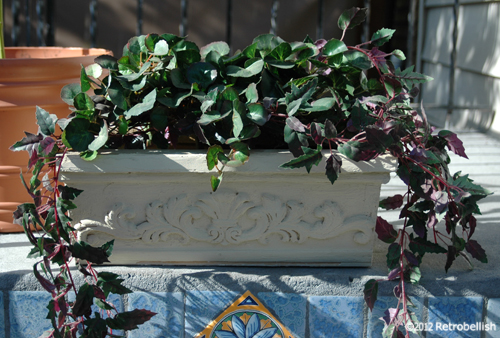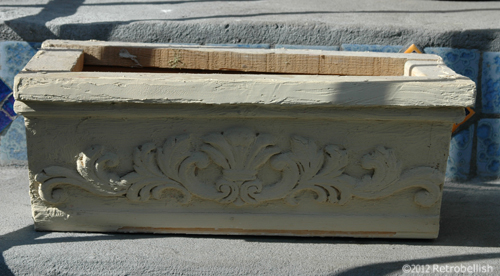Scrap Styrofoam Relic

This project started out with a large broken piece of insulation Styrofoam, some scrap wallpaper and a scoop of leftover dry wall compound that we wanted to recycle. We decided to try to make some kind of art from these leftover materials. The great part of this project was that the art piece would be very light and hang on any wall with just a small nail or piece of double-sided tape. I decided to try and make some kind of faux stone tablet relic.
I started out by breaking away pieces from the edges of the Styrofoam in an uneven pattern all the way around to give it a broken stone tablet look. I then added a coat of drywall compound across the whole front and sides of the Styrofoam piece, and then cut pieces of the scrap textured wallpaper about an inch shorter from the edges of the Styrofoam (loosely following the jagged shape of the Styrofoam) and pushed it right into the drywall compound. Using my hands, I smoothed some drywall compound over the wallpaper covering most of the wallpaper edges, but smoothing out the compound to reveal the main wallpaper details.
While the piece was still damp, I painted the whole thing with a taupe acrylic enamel paint. The reason for this was to get the deep taupe color into the drywall compound while drying and with a damp paper towel I gently removed some of the paint away from the details. I then let the piece dry for a few days and repainted the whole piece again, highlighting the raised points with a darker taupe to accent the piece. After everything was dry, I placed a very small nail into the wall and gently pushed the Styrofoam art piece into the small nail. Styrofoam is a very versatile and fun medium to work with because of its light and smooth surface — it lends itself to many craft projects.
Cigar Box Folk Art Purse
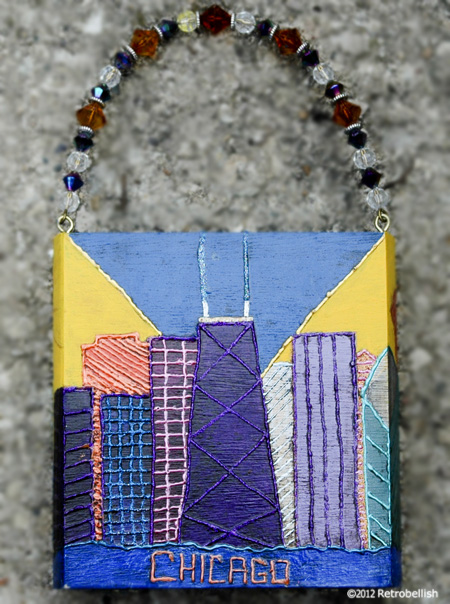
Cigar box purses were once very popular and a great way to reuse these great boxes made out of wood or chipboard that could be used for a multitude of craft projects from jewelery boxes to purses. We used some of these for a lot of our folk art projects where we painted city and farm scenes on the boxes. The box featured here is an abstract rendition of our city of Chicago’s famous landmarks. And although this purse was used as folk art, some of our other pieces were functional purses lined inside with velour fabric and a small mirror.
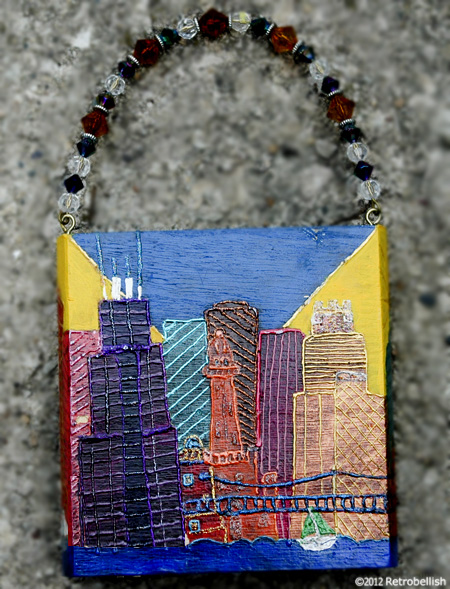
The blue water, and blue and yellow background on this purse were painted with acrylic latex craft paints. Once the paint dried, we used fabric craft paints to paint the abstract Chicago scene. About an hour after everything dried, we used clear latex acrylic sealer to seal it. The purse handle was a pre-made handle reclaimed from a previously scrapped project. Cigar boxes make a great craft project to make at home with children and friends. These boxes could also be found at any big box craft store alongside other shaped boxes and paper mache boxes. So just have fun and create your own piece of art.
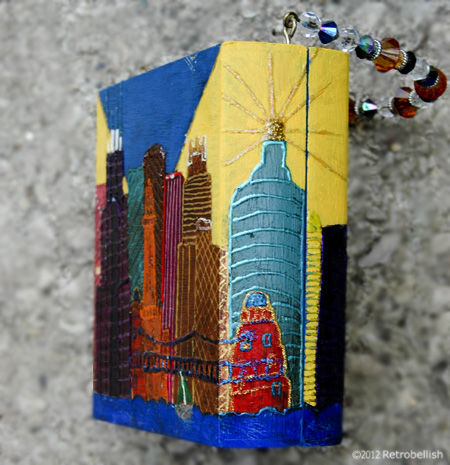
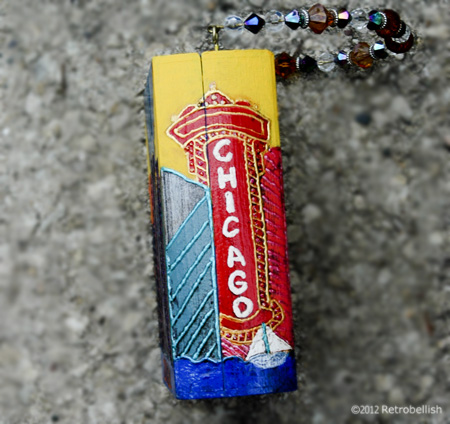
Plastic Bottle Trash Art Flowers
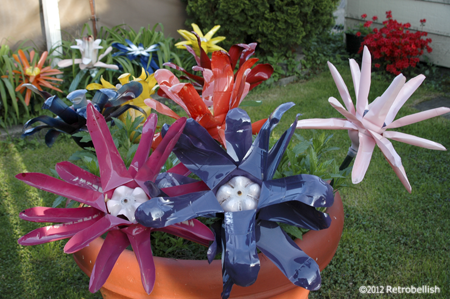
One of the most important elements of crafting for us is to recycle as much as we can. The house is a great place to start recycling projects because it is easy to see what objects we tend to throw out the most in our trash. Whether it’s plastic, paper, glass or metal, it is a challenge to find creative ways to incorporate the trash materials into our arts and crafts. One way we thought of adding color to our yard all year round here in Chicago was to make some kind of art with plastic pieces. And what better medium to reclaim than 50 plastic soda bottles for flowers we had in mind. We started to cut the plastic bottles in different strip cuts to imitate flower pedals.
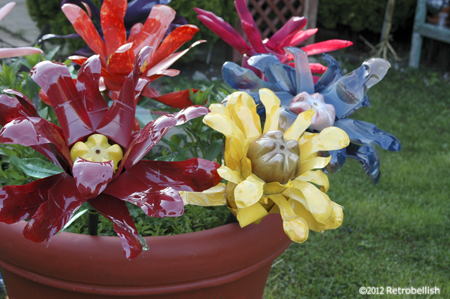
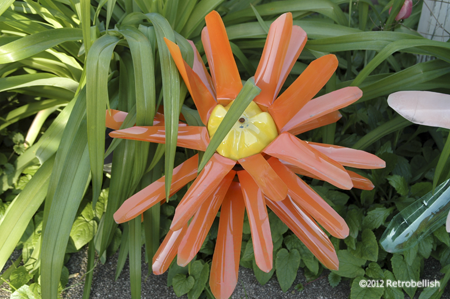
After we cut the pedals in different dimensions to create different style flower pedals, we painted the back of the pedals with vibrant enamel colors. Next, we let them dry and took an 18 inch long dowel rod that we had recycled from old VHS racks we had taken apart. We hand painted the dowel rods with a green indoor- outdoor acrylic paint. When we cut out the initial pedals, we cut out the bottom of the bottles all the way around and these are what make the center of each flower. We next painted the flower centers in complimentary colors to the flower colors. We then placed the painted bottom (used as the center of the flower) over one end of the dowel rod and drilled a screw right in the middle of the center and into the dowel rod.
This creates the middle center of the flower. Next we took three of the bottles we had painted and flipped them upwards. We then took a green bottle to create the leaves and placed this first on the dowel rod. Next we placed one of the flower pedals and pushed it up tightly onto the dowel rod. Then we drilled a screw under the edge of the last bottle/flower pedals to hold them in place. You can rotate each row of bottles/pedals to align the flower pedals to look any way that you’d like. The flower pedals can be painted in any color combination that you’d like. We left our flowers outside throughout the entire winter and they looked beautiful against the white snow. These recycled plastic bottle flowers allow you to have a beautiful colorful garden all year round.
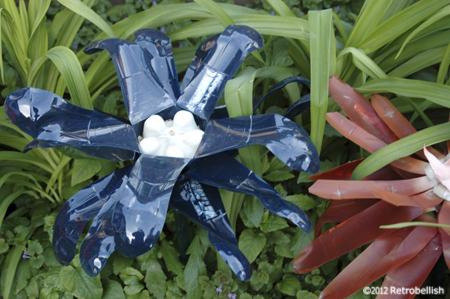
Not only is recycling great for our environment, but it is also a fun way to craft with family and friends.
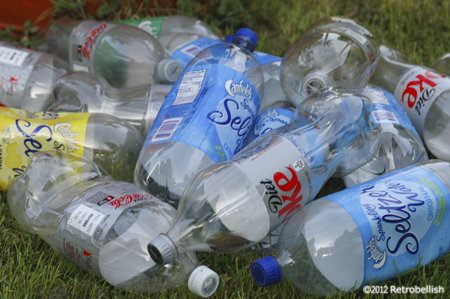
Scrap Wood Flower Box
This wood flower box started out as pieces of scrap wood that we had left over after one of our rehab projects. I originally wanted save the scrap wood pieces to paint folk art farm scenes. I painted on the smaller scrap wood pieces, which at the time I was selling at our local craft shows. My husband reused some of the drywall screws that were left over to put the box together. He also used some pieces of scrap moldings and an old wood applique we had reclaimed. We then spread drywall compound on the outside of the box with an old dried out paint brush to give it a rustic look we were looking for and once the drywall compound thoroughly dried, we painted the box with a cream colored latex paint. I added some silk vines I had lying around in my basement, and the final project turned out exceptionally well. Although I decided to use silk vines in mine, if one wanted to use a real plant, you could use any plastic bag or liner in the box and drill two holes at the bottom for drainage. So don’t hesitate to play around with scrap wood pieces. See what you can create and just have fun.
Forest Maiden Paper Mache Mask
In the past, when working on paper mache projects, I’ve always made small paper mache items, but I’ve always wanted to try making a large paper mache mask. I thought about the many different style masks I’ve seen on television, in books and at museums. I drew several rough sketches on paper and finally decided to try and make an abstract mask that looked like a forest maiden with leaves for hair.
I found a large piece of masonite board in the garage that I thought would be a perfect size base for my mask. I dusted off the board and wiped it clean. I then gathered a stack of old newspapers and started tearing up sheets into medium size pieces (about 3 to 6 inch pieces). I continued until I had a large pile of torn newspaper pieces. I then made the paper mache paste using flour and water – with a dash of salt as a preservative.
I took some of the larger newspaper pieces and started soaking them into the paste mixture. I first started the mask with the face by placing some of the bigger soaked chunks down on the board. Once I started forming the face, I started to place smaller soaked pieces on top of the base pieces by laying them on as smoothly as possible.
Once I formed a shape resembling a pleasing face, I worked on building up the forehead, the eyebrow areas and then the cheek bones. I rolled and soaked several torn pieces together and placed those large soaked pieces in the area where the nose would go and then did the same with the mouth, which I decided to make slightly open. I then worked on the hair, which I tried as closely as possible to resemble leaves. It is an abstract piece that measures 16 inches in length and 14-1/2 inches wide (the board measures 24 inches by 24 inches). Once I felt it was done, I was very pleased with the entire piece.
Although I started this project on a weekend, I let it dry thoroughly for a week before I primed it with a coat of gesso. The piece is primed and ready to be painted or even embellished with pieces of fabric, beads, small found objects or leftover jewelry pieces, but that will be the next project. I really enjoyed making this mask, and although I used old newspapers, you can always use magazines or any kind of scrap paper to make this project. You can use craft paint, a color wash or patina to paint your piece or any technique you’d prefer.
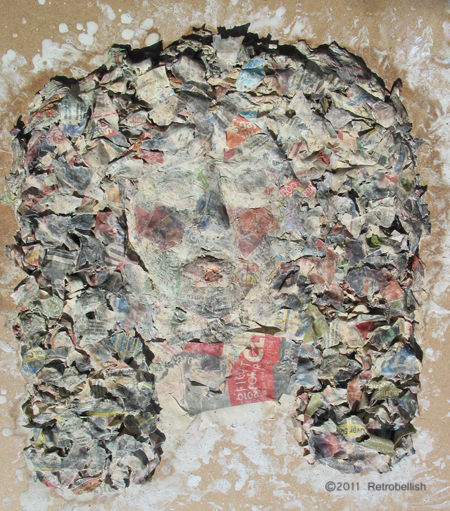
Forest Maiden Paper Mache Mask Before Primer
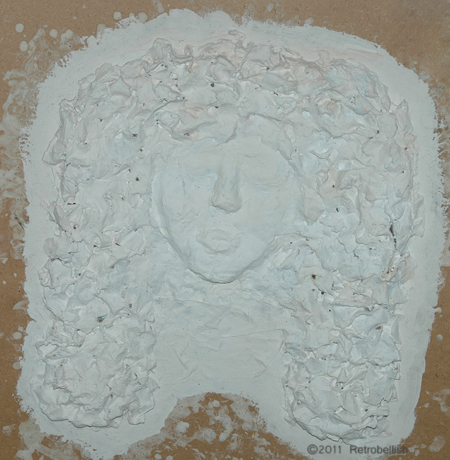
Forest Maiden Paper Mache Mask Primered with Gesso.
